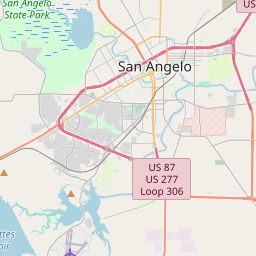Municipal Swimming Pool
Historical marker location:






In September 1936 a devastating flood swept down the South Concho River, inundating much of the city of San Angelo. Among the many properties lost or severely damaged were the city's parks and its public swimming pool. Plans were made to rebuild the parks and construct a new municipal swimming pool, but a bond election held in 1937 to finance the project was defeated by the voters. Once it was determined that the federal government would assist with Works Progress Administration funds and labor for the project, a new bond election was held and passed by sixty-six votes. Work on the project began in March 1938 and was completed in October. Opening ceremonies were held on April 29, 1939. During its first two days of operation, the pool hosted 795 swimmers. Designed by John G. Becker, the Pueblo revival complex features a two-story hexagonal stone structure flanked by one-story wings. Exposed vigas are symmetrically placed on the upper portion of the wings. The complex reflects the 1930's construction and planning activity of the Federal Works Progress Administration.
Recorded Texas Historic Landmark - 1989
As one of the most visible programs of the Texas Historical Commission (THC), historical markers commemorate diverse topics in Texas history, including: the history and architecture of houses, commercial and public buildings, religious congregations, and military sites; events that changed the course of local and state history; and individuals who have made lasting contributions to the state, community organizations, and businesses.
The Battle of San Jacinto fought on April 21, 1836, was the decisive battle of the Texas Revolution, and led to the capture of Santa Anna and the end of the conflict.
In the late 1800s, the county began to attract settlers looking for opportunities in ranching and agriculture. This period saw an influx of farmers and ranchers who developed the land for cattle and sheep grazing, as well as growing crops such as cotton, corn, and wheat. The population increased significantly during this time, leading to the official organization of Tom Green County in 1874.
The county experienced rapid growth during the late 19th century, thanks to the establishment of Fort Concho and the expansion of the railroad. Fort Concho served as a primary military post protecting settlements against Native American raids and fostered economic growth by providing stability and resources to the region. Additionally, the arrival of the railroad in the 1880s further spurred economic development, making transportation of goods easier and stimulating trade.
In the early 20th century, Tom Green County faced several challenges, including droughts and the Great Depression. However, the county managed to overcome these obstacles and continued to thrive. Today, Tom Green County is known for its agriculture, oil and gas production, and as a center for healthcare and education. With a rich history that encompasses Native American heritage, frontier life, military significance, and economic growth, Tom Green County has played a vital role in the development of West Texas.
Tom Green County Timeline
This timeline provides a concise overview of the key events in the history of Tom Green County, Texas.
- 1874 - Tom Green County is organized and named after Confederate General Thomas Green.
- 1882 - The first courthouse in Tom Green County is built in the city of Ben Ficklin.
- 1884 - San Angelo becomes the county seat after a contentious election.
- 1886 - The Texas and Pacific Railway line is extended to San Angelo, boosting the city's economy.
- 1899 - San Angelo is incorporated as a city.
- 1928 - Goodfellow Air Force Base is established as a training facility during World War II.
- 1952 - Construction of the O.H. Ivie Reservoir begins on the Colorado River near San Angelo.
- 1995 - The San Angelo Museum of Fine Arts opens.
- 2002 - San Angelo experiences a devastating flood, causing significant damage to the city.
- 2015 - The San Angelo Stock Show and Rodeo celebrates its 83rd anniversary.